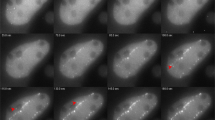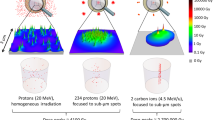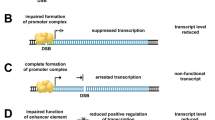Abstract
We have built an ion-microbeam for studies of the nuclear topography and kinetics of double-strand break repair at the single cell level. Here, we show that a first and a second, delayed single ion exposure at different nuclear sites led to comparable accumulations of phospho-ATM, γ-H2AX and Mdc1 at both earlier (e) and later (l) microirradiated sites. In contrast, accumulations of 53BP1 and the recombination protein Rad51 were strongly reduced at l-sites. This apparent competition effect is accompanied by a reduced amount of 53BP1 in undamaged areas of the irradiated nuclei. We suggest that a critically limited pool size combined with strong binding at irradiated sites leads to the exhaustion of unbound factors freely roaming the nuclear space. The undersupply of these factors at l-sites requires in addition a long-lasting binding at e-sites or a weaker binding at l-sites. The observed effects suggest that DNA damage response at individual nuclear sites depends on the time course of damage load. This may have implications for therapeutic radiation treatments.





Similar content being viewed by others
References
Khanna KK, Jackson SP (2001) DNA double-strand breaks: signaling, repair and the cancer connection. Nat Genet 27:247–254
Lavin MF, Birrell G, Chen P, Kozlov S, Scott S, Gueveen N (2005) ATM signaling and genomic stability in response to DNA damage. Mutat Res 569:123–132
Sedelnikova OA, Pilch DR, Redon C, Bonner WM (2003) Histone H2AX in DNA damage and repair. Cancer Biol Ther 2:233–235
Carson CT, Schwartz RA, Stracker TH, Lilley CE, Lee DV, Weitzmann M (2003) The Mre11 complex is required for ATM activation and the G2/M checkpoint. EMBO J 22:6610–6620
Horejsi Z, Falck J, Bakkenist CJ, Kastan MB, Lukas J, Bartek J (2004) Distinct functional domains of Nbs1 modulate the timing and magnitude of ATM activation after low doses of ionizing radiation. Oncogene 23:3122–3127
Lee JH, Paull TT (2004) Direct activation of the ATM protein kinase by the Mre11/Rad50/Nbs1 complex. Science 304:93–96
Lee JH, Paull TT (2005) ATM activation by DNA double-strand breaks through the Mre11-Rad50-Nbs1 complex. Science 308:551–554
Bakkenist CJ, Kastan MB (2004) DNA damage activates ATM through intermolecular autophosphorylation and dimer dissociation. Nature 421:499–506
Huyen Y, Zgheib O, DiTullio RA, Gorgoulis VG, Zacharatos P, Petty TJ, Sheston EA, Mellert HS, Stavridi ES, Halazonetis TD (2004) Methylated lysine 79 of histone H3 targets 53BP1 to DNA double-strand breaks. Nature 432:406–411
Mochan TA, Venere M, DiTullio RA, Halazonetis TD (2003) 53BP1 and NFBD1/MDC1-Nbs1 function in parallel interacting pathways activating ataxia-telangiectasia mutated (ATM) in response to DNA damage. Cancer Res 63:8586–8591
Wang B, Matsuoka S, Carpenter PB, Elledge SJ (2002) 53BP1, a mediator of the DNA damage checkpoint. Science 298:1435–1438
Stewart GS, Wang B, Bignell CR, Taylor AMR, Elledge SJ (2003) MDC1 is a mediator of the mammalian DNA damage checkpoint. Nature 421:961–966
Peng A, Chen PL (2003) NFBD1, like 53BP1, is an early and redundant transducer mediating Chk2 phosphorylation in response to DNA damage. J Biol Chem 278:8873–8876
Zgheib O, Huyen Y, DiTullio RA, Snyder A, Venere M, Stavridi ES, Halazonetis TD (2005) ATM signaling and 53BP1. Radiother Oncol 76:119–122
DiTullio RA, Mochan TA, Venere M, Bartkova J, Sehested M, Bartek J, Halazonetis TD (2002) 53BP1 functions in an ATM-dependent checkpoint pathway that is constitutively activated in human cancer. Nat Cell Biol 4:998–1002
Hauptner A, Dietzel S, Drexler GA, Reichart P, Krücken R, Cremer T, Friedl AA, Dollinger G (2004) Microirradiation of cells with energetic heavy ions. Radiat Environ Biophy 42:237–245
Reichart P, Datzmann G, Hauptner A, Hertenberger R, Wild C, Dollinger G (2004) Three-dimensional hydrogen microscopy in diamond. Science 306:1537–1540
Dollinger G, Hable V, Hauptner A, Krücken R, Reichart P, Friedl AA, Drexler GA, Cremer T, Dietzel S (2005) Microirradiation of cells with energetic heavy ions. Nucl Instr Meth B 231:195–201
Datzmann G, Dollinger G, Goeden C, Hauptner A, Körner HJ, Reichart P, Schmelmer O (2001) The Munich microprobe SNAKE: first results using 20 MeV protons and 90 MeV sulfur ions. Nucl Instr Meth B 181:20–26
Greubel C, Hable V, Drexler GA, Hauptner A, Dietzel S, Strickfaden H, Baur I, Krücken R, Cremer T, Friedl AA, Dollinger G (2008) Quantitative analysis of DNA-damage response factors after sequential ion microirradiation. Radiat Environ Biophys (submitted)
Pryde F, Khalili S, Robertson K, Selfridge J, Ritchie AM, Melton DW, Jullien D, Adachi Y (2005) 53BP1 exchanges slowly at the sites of DNA damage and appears to require RNA for its association with chromatin. J Cell Biol 118:2043–2055
Bekker-Jensen S, Lukas C, Melander F, Bartek J, Lukas J (2005) Dynamic assembly and sustained retention of 53BP1 at the sites of DNA damage are controlled by Mdc1/NFBD1. J Cell Biol 170:201–211
Botuyan MV, Lee J, Ward IM, Kim JE, Thompson JR, Chen J, Mer G (2003) Structural basis for the methylation state-specific recognition of histone H4-K20 by 53BP1 and Crb2 in DNA repair. Cell 127:1361–1373
Celeste A, Fernandez-Capetillo O, Kruhlak MJ, Pilch DR, Staudt DW, Lee A, Bonner RF, Bonner WM, Nussenzweig A (2003) Histone H2AX phosphorylation is dispensable for the initial recognition of DNA breaks. Nat Cell Biol 5:675–679
Bekker-Jensen S, Lukas C, Kitagawa R, Melander F, Kastan MB, Bartek J, Lukas J (2006) Spatial organization of the mammalian genome surveillance machinery in response to DNA strand breaks. J Cell Biol 173:195–206
Murr R, Loizou JI, Yang YG, Cuenin C, Li H, Wang ZQ, Herceg Z (2006) Histone acetylation by Trrap-Tip60 modulates loading of repair proteins and repair of DNA double-strand breaks. Nat Cell Biol 8:91–99
Downey M, Durocher D (2006) Chromatin and DNA repair: the benefits of relaxation. Nat Cell Biol 8:9–10
Acknowledgments
We thank the staff of the Maier–Leibnitz-Laboratorium for operating the accelerator and F. Eckardt-Schupp, GSF Research Centre Neuherberg, for providing access to the α-irradiation facility. This work was supported by grants of the European Science Foundation (ESF) under the EUROCORES Programme EuroDYNA (G.D., T.C., A.A.F.), the DFG Cluster of Excellence Munich Centre for Advanced Photonics (G.D., A.A.F.), the Bundesamt für Strahlenschutz (A.A.F.) and the Bundesministerium für Bildung und Forschung (A.A.F.).
Author information
Authors and Affiliations
Corresponding author
Additional information
Christoph Greubel, Volker Hable and Guido A. Drexler contributed equally to this work.
Rights and permissions
About this article
Cite this article
Greubel, C., Hable, V., Drexler, G.A. et al. Competition effect in DNA damage response. Radiat Environ Biophys 47, 423–429 (2008). https://doi.org/10.1007/s00411-008-0182-z
Received:
Accepted:
Published:
Issue Date:
DOI: https://doi.org/10.1007/s00411-008-0182-z




